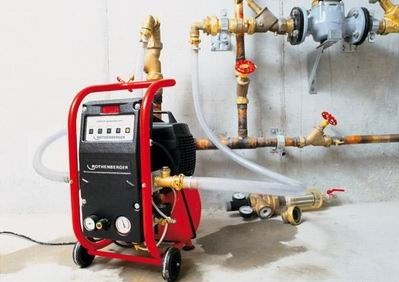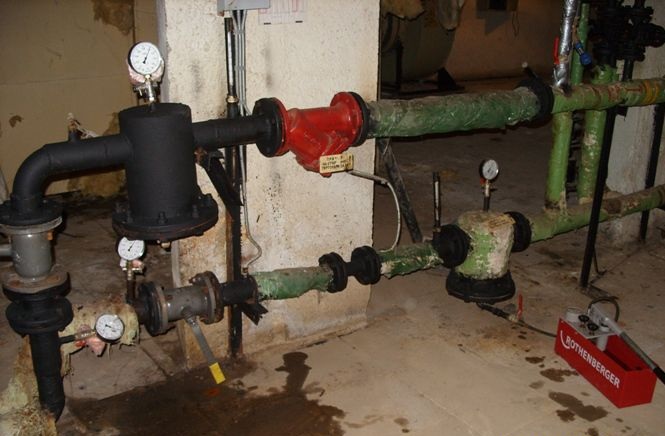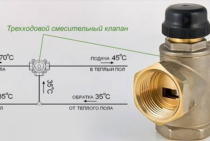The act of checking the readiness of the technical condition and the serviceability of the fire-fighting equipment for operation in winter conditions 20______ 20______.
"____" _________________ 20____
|
The address ______________________________________________________ Purpose of the object (residential, public, etc.) _________________________________________________ |
||
|
Building ownership |
||
|
(ZHSK, HOA, urban housing stock, etc.) |
||
|
Floors _________________________________________________ Year of construction ______________ The main criteria for assessing the readiness of the technical condition and serviceability of the fire-fighting equipment of residential and public buildings for the new heating season: 1. Availability, maintenance and serviceability of primary fire extinguishing equipment: |
||
|
3. Availability, maintenance of internal fire water supply: |
||
|
(available/absent, good/faulty) |
||
|
4. Availability, serviceability of automatic fire protection systems |
||
|
(available/absent, serviceable/faulty) |
||
|
5. Availability, serviceability of means of warning people about a fire, control |
||
|
fire evacuation: |
||
|
(available/absent, serviceable/faulty) |
||
|
(match/do not match) |
||
|
7. Carrying out fire retardant treatment of wooden structures of attic spaces (if any) after the expiration of the treatment (impregnation) and in case of loss of fire retardant properties of the compositions: |
||
|
(passed/not passed, date of last processing) |
||
|
8. Operation of electrical networks, electrical installations and electrical products, as well as monitoring their technical condition in accordance with the requirements of regulatory documents on |
||
|
power industry**: |
||
|
(control is carried out / not carried out, meet the requirements / do not meet) |
||
|
9. Compliance with the legal instructions of the State Fire Commission on the elimination of violations of fire safety requirements in a timely manner: |
||
|
(performed / not implemented, % of the fulfillment of prescription items) |
||
|
Assessment by the responsible manager (owner of the building) of the readiness of the technical condition and serviceability of the fire-fighting equipment of residential and public buildings for a new heating |
||
|
(done / not ready) |
||
|
(Full name) of the responsible manager (owner of the building) |
(signature) |
|
* - for high-rise buildings (over 10 floors), an act of work performed and a copy from the register of maintenance work (MS) and scheduled preventive maintenance (SPM) are attached, indicating that maintenance has been carried out in accordance with the work schedule.
** - excerpt from the conclusion based on the results of measurements of insulation resistance and grounding of power and lighting electrical equipment with a defective statement attached.
preparation
and holding
general meeting of shareholders 6) preliminary statement
annual…
Heat supply flushing methods
It is not recommended to start flushing the heating system without prior preparation. It is necessary to determine the chemical composition of scale, select a specific type of equipment for cleaning.
A process map will help you to correctly complete the necessary steps, which prescribes all the stages of the procedure. The last regulation ends with the treatment of the inner area of the pipes with a chemical composition to prevent the appearance of corrosion, lime deposits, and scale.
The main washing methods are as follows:
- chemical way;
- hydrodynamic;
- hydropneumatic.
Chemical flushing of the coolant
This method does not involve the intervention of mechanical devices and the dismantling of radiators. Cleaning is carried out with chemicals or solutions.
However, the use of the method can damage the inner plane of aluminum radiators, which is fraught with their destruction.
If the heating network is not very clogged, you can use reagents:
- sodium hydroxide;
- vinegar essence;
- ordinary phosphoric or condensed acid;
- whey.
However, it is better to use compounds that allow you to thoroughly clean the pipes.The instructions for preparations stipulate the material, the nature of the layers.
Chemical treatment can be carried out with the help of additional equipment - a booster, consisting of a centrifugal pump and a large capacity. The first one is connected at the break of the supply centralized system with a heating boiler. At the outlet of the circuit, a valve must be installed to discharge the spent chemical.
For high-quality corrosion of lime deposits, experts recommend leaving the reagent in the network for several days, depending on its slagging. However, to avoid exposure of the pipes to the chemical, the circuit must be flushed with process water or tap water after cleaning.
More sparing metal structure - dispersed cleaning mode. The method differs from the chemical method in that the reagent destroys the mechanical bonds of the deposits themselves, without interacting with the material of the heating communications.
Hydrodynamic cleaning
The described operation is carried out using specialized equipment. One of them seems to be a powerful centrifugal pump with a hose having a small diameter end nozzle. A strong pressure of water cleans scale, deposits from the walls of heating mains, removes them through the return.
Mechanical flushing method
Method for cleaning radiators, small pipes. The shut-off valves, expansion tank and centrifugal pump must be cleaned separately. Before the procedure, it is necessary to carry out a minimum drain of the system at home, and then close the inlet, drain valves. Only after that proceed to reset the rest of the carrier.
The discharge occurs through a drain valve installed in the basement, which communicates with the sewer through a hose. This will prevent flooding of the tech subfield with water. Heatsinks are cleaned by unscrewing the plug and ejecting the media. However, dismantling the battery and processing will improve the thermal performance of the radiator.
After the dismantling of radiators, sections of heating distribution to the yard, the equipment is cleaned with a cable with a tip in the form of a brush. The introduction of the tool into the battery is carried out in the position of the reverse supply of the thermal resource to improve the removal of scale scales, layers. Cleaning is carried out until the washing water becomes clear.
Hydropneumatic
Belongs to an effective and equipment-friendly method of cleaning heating circuits. Contained in high pressure air jet supply. The compressor creates turbulent flows of high power inside the communications, leading to the breakdown of growths and the washing out of accumulated dirt.
The operation is carried out with a pneumatic gun that delivers short-term impulses. Lime deposits are discharged through open radiator caps. The initial purge procedure is carried out against the flow of the coolant, the second one - clockwise. Will improve the air operation of dismantling the batteries with their cleaning on the street.
Electrohydropulse cleaning option
The method is based on the formation of an electric discharge, the shock wave of which breaks lime deposits on the inner walls of the system, without causing harm to the latter. For cleaning, you will need a voltage generator, a coaxial cable for supplying high-frequency signals.
The efficiency of the method is high, therefore, the dismantling of radiators, the entire heating circuit is not provided. After the destruction of the scale, the coolant is washed, the water goes into the sewer.
The list of requirements imposed by the heat supply organization when checking the readiness of heat consumption systems of a residential building for operation in the heating season
1. Availability check:
1.1. Schematic diagram of heat networks owned by the subscriber (from the boundary of the balance delimitation to the ITP (CTP).
1.2. Schematic diagram of the ITP (CTP) and the distribution manifold, indicating the diameters of the throttle diaphragms and nozzles, connected consumers.
1.3.The act on the repair work performed on the equipment owned by the subscriber, signed by the person responsible for the good condition and safe operation of thermal power plants:
Preventive repair and cleaning of heating surfaces of water heaters; — preventive maintenance and adjustment of safety valves in ITP (CTP); — preventive maintenance of pressure regulators; – preventive maintenance of hot water temperature controllers; — check valve revisions;
Repair of fittings, pumps, regulators, mud collectors and filters; — cleaning, preventive maintenance of equipment of thermal chambers, heat pipelines, associated drainage.
2. Strength and density test of heat networks, central and individual heating points, in-house heat supply and heat consumption systems (ventilation, hot water supply and heating), which are on the balance of the consumer (subscriber).
3. Flushing of the heating network and heat consumption systems, which are on the balance of the subscriber, by hydraulic (1 time per year) and hydropneumatic (1 time in 2 years) methods.
4. Check (in the presence of a responsible manager for the good condition and safe operation of thermal power plants):
4.1. The presence of thermometers and pressure gauges that have passed state verification in the ITP (CTP) of buildings.
4.2. Actual orifice diameters of nozzles and orifice plates according to the commissioning reports and, if necessary, install them.
4.3. Insulation of pipelines of external heating networks of ITP (CTP), internal systems (if necessary, restoration).
4.4. ITP stop valves numbering according to the schematic diagram.
4.5. Conditions of basements, ITPs (CTPs) where technical equipment and heat pipelines are located (cleaning the premises, lighting, constipation, etc.). Ensuring a free installation and operation zone (no obstruction of passages) of heat pipelines and equipment.
5. Elimination of comments by the heat supply organization and supervisory authorities identified during the heating season.
After completing the above work, a representative of the heat supply organization is called to accept the heat consumption systems of a residential building for operation in the heating season with the execution of a bilateral Act. It is allowed to check the readiness of the object for operation in the heating season in stages with the preparation of working (intermediate) acts.
If the consumer (subscriber) by September 01 does not have an Act on the readiness of heat consumption systems of a residential building for operation in the heating season, signed by a representative of the heat supply organization, the heat supply organization sends information for taking measures to the State Housing Inspectorate of St. Petersburg.
After the issue of the order of the Committee for Energy and Engineering on the beginning of periodic heating of buildings in St. Petersburg, the supply of thermal energy to the consumer (subscriber) will be carried out:
1. If there is an Act on checking the readiness of heat consumption systems of a residential building for operation in the heating season.
2. In the absence of overdue debts for consumed heat energy as of September 01 of the current year.
P.S. In accordance with the Rules for the technical operation of thermal power plants, approved by order of the Ministry of Energy of the Russian Federation dated March 24, 2003 N 115, testing of the equipment of installations and heat consumption systems for density and strength should be carried out after they are washed by the personnel of the consumer of thermal energy with the obligatory presence of a representative of the heat supply organization.
Appendix N 10b
To
Rules
preparation and conduct
heating season in St. Petersburg
Normative documentation, rules and SNiP for pressure testing of the heating system
Brief excerpts from normative documentation, rules and SNiP for pressure testing of heating .
Analyzing the statistics of the questions you ask and realizing that many questions on pressure testing of the heating system for the majority of our audience remain incomprehensible to you, we decided to make a selection from the necessary points and the Rules for pressure testing, approved by the Ministry of Fuel and Energy of the Russian Federation and SNiP.
All SNiPs and rules contain information on more than 100 pages, which are sometimes difficult to understand, therefore, in order to make it easier for you to see and, if necessary, refer to the required paragraph of a particular regulatory document, we have processed the applicable regulatory documents and in a brief form posted on the site. Explanations to the Rules and SNiP can be found in the article: "Norms and rules for pressure testing of the heating system"
Frequency of flushing heat supply
When the coolant passes through the pipeline, scale is deposited on the inner walls of the latter, which reduces heat transfer by at least 20%. Deposits destroy the metal, after which fistulas and ruptures appear.
Unscheduled flushing of heat supply
The procedure is carried out after the appearance of factors that reduce the effectiveness of the circuit:
- network heating requires additional time;
- cold radiators with a hot system;
- extraneous sounds during the operation of the generator;
- increased fuel consumption of the boiler.
With unevenly heated batteries, the heating systems are also flushed.
Treatment steps for cleaning and rinsing
Heat consumption nodes are processed in the following sequence:
- Conduct a check of communications, an assessment of their technical condition. Primary pressure testing is performed, and the pressure is set one quarter higher than the working pressure. The procedure helps to identify system leaks.
- Block washing technology is determined. The usual method is to run a slurry consisting of a liquid with compressed air.
- An estimate is being made.
- An agreement is drawn up, which specifies all the conditions of the operation, deadlines, obligations of counterparties, penalties in case of violation of the first one.
- Then a work contract is drawn up.
- After completion, a repeated hydraulic test is carried out.
The end of flushing is determined by the execution of the act of cleaning and hydraulic testing of the network. If the quality of the procedure is unsatisfactory, the customer has the right not to sign the agreement.
Hydraulic test parameters
When conducting a pipeline quality check, it is necessary to determine the indicators of the following work parameters:
- Pressure.
- Temperatures.
- Holding time.
The lower limit of the test pressure is calculated using the following formula: Ph = KhP
. The upper limit should not exceed the sum of the total membrane and bending stresses, which will reach 1.7 Th. The formula is deciphered as follows:
- Р is the design pressure, the parameters of which are provided by the manufacturer, or the working pressure, if the tests are carried out after installation;
- Th is the rated voltage that is allowed at the test temperature Th;
- T is the allowable stress at design temperature T;
- Kh is a conditional coefficient that takes on a different value for different objects. When checking pipelines, it is equal to 1.25.
The water temperature should not fall below 5°C and rise above 40°C. The only exceptions are those cases when the temperature of the hydro component is indicated in the technical specifications of the object under study. Be that as it may, the air temperature during the test should not fall below the same 5 ° C.
The exposure time must be specified in the design documentation for the facility. It should not be less than 5 minutes. If exact parameters are not provided, then the holding time is calculated based on the thickness of the walls of the pipeline. For example, with a thickness of up to 50 mm, the pressure test lasts at least 10 minutes, with a thickness of more than 100 mm - at least 30 minutes.
Testing of fire hydrants and water mains
A hydrant is equipment responsible for the rapid elimination of fire ignitions, so it must always be in working condition. The main task of fire hydrants is to provide the optimal amount of water to fight a fire at its initial stage.
Act on flushing and pressure testing of the heating system
Drawing up an act on the performance of work summarizes the procedure for flushing, hydraulic testing of the heating circuit of a multi-storey building. Properly carried out cleaning will allow house communications of artificial heating to work next season.
The act of flushing and pressure testing of the heating system, a sample of which is given below, contains the following information:
- the address of the location of the communication, its type - open, closed;
- cleaning method;
- materials, their volume, quantity;
- date of work;
- analysis.
At the bottom of the document, the signatures of counterparties - the customer and the contractor are put.
The form of the act of flushing heat consumption systems can be downloaded here.
Why and when to conduct hydraulic tests
Hydraulic testing is a type of non-destructive testing that is carried out to check the strength and tightness of pipeline systems. All operating equipment is exposed to them at different stages of operation.
In general, there are three cases in which testing must be mandatory
regardless of the purpose of the pipeline:
- after the completion of the production process for the production of equipment or parts of the pipeline system;
- after completion of the installation work of the pipeline;
- during the operation of the equipment.
Hydraulic testing is an important procedure that confirms or disproves the reliability of a pressure system in operation. This is necessary to prevent accidents on highways and preserve the health of citizens.
A procedure is being carried out for hydraulic testing of pipelines in extreme conditions. The pressure under which it passes is called test pressure. It exceeds the usual working pressure by 1.25-1.5 times.
Features of hydraulic tests
Test pressure is supplied to the pipeline system smoothly and slowly so as not to provoke water hammer and the formation of accidents. The pressure value is determined not by eye, but by a special formula, but in practice, as a rule, it is 25% more than the working pressure.
The force of water supply is controlled on pressure gauges and measurement channels. According to SNiP, jumps in indicators are allowed, since it is possible to quickly measure the temperature of the liquid in the pipeline vessel. When filling it, it is imperative to monitor the accumulation of gas in different parts of the system.
This possibility should be ruled out at an early stage.
After filling the pipeline, the so-called holding time begins - the period during which the equipment under test is under increased pressure
It is important to ensure that it is at the same level during exposure. After its completion, the pressure is minimized to a working state.
Personnel serving it must wait in a safe place, as checking the functionality of the system can be explosive. After the end of the process, the results obtained are evaluated according to SNiP. The pipeline is inspected for metal explosions, deformations.
Step-by-step instructions for an independent procedure for cleaning the coolant
It is possible to clean the artificial heating system of a building without a third-party organization. This will require a pneumatic diaphragm pump capable of raising pressure above 6 atmospheres. Before starting the operation, it is necessary to close all the valves, unscrew the end caps of the radiators with a wrench.
Algorithm:
- Close the resource outlet valve.
- Connect the diaphragm pump to the valve located after the stop valves.
- Discard the used coolant.
- Turn on the diaphragm pump, raise the pressure to 6 at.
- Open the system valve.
- Turn off all house heating risers in turn. No more than 10 apartment highways should be closed for one run.
After the operation, through the return line, you need to connect the pump to the carrier inlet to the building. However, before this, it is necessary to drain the heating. After high-quality processing of the contour, the water should come out clear.



